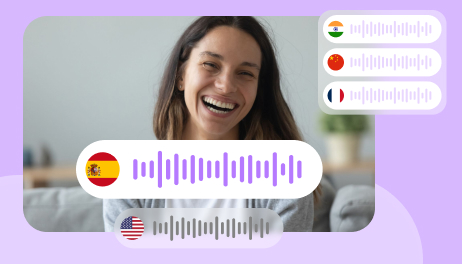Wondering whether you can translate your voice? Well, the answer is YES!
With today’s technology, translating your voice into different languages is as simple as clicking a button on a phone.
Now, no more struggling to communicate while traveling, no more language barriers, and no more awkward moments when talking to someone who speaks a different language. Because voice translation makes it much easier and truly transforms how we interact.
So, ready to explore how you can translate your voice and its importance? Let’s get started!
What Exactly Is Voice Translation?
Voice translation is a fantastic way of transforming one language into another. It works like a bridge between different languages and allows people to communicate easily with anyone. You just speak, and the system translates your words automatically, so you can connect with others effortlessly, whether they speak Spanish, French, or any other language. Sounds amazing, right?
Moreover, the process of voice translation is so simple and involves three major steps:
- Speech Recognition: The software captures your voice and turns the words into text using speech-to-text technology.
- Translation: Then, it translates that text into your preferred language.
- Text-to-Speech: At last, the tool generates the translated words in the other language.
Additionally voice translation can be used for traveling, business meetings, or even chatting with someone from another language. This is a great tool to increase your reach globally, breaking down the differences between languages. So, with voice translation, the world feels a lot more connected!
Why Would You Want to Translate Your Voice?
Voice translation goes beyond being just a technological feature; it’s transforming how we communicate, learn, and entertain. It opens doors in different fields by allowing us to hear familiar voices in unfamiliar languages. The reasons why you need to translate your voice are:
- Broaden Your Audience: Translating your voice allows you to connect with people from various linguistic backgrounds. This opens new opportunities for engagement and collaboration across cultures. According to research, 76% of people want to buy products with information in their native language.
- Improve Accessibility: Not everyone speaks the same language as you do. Translations help them understand what you are saying. This is especially true in the global market context.
- Enhance Understanding: Language gaps can lead to misunderstandings. When you translate your voice, your message becomes clearer and resonates with your audience. This approach prevents miscommunication and builds trust.
- Boost Professionalism: Sharing messages in different languages shows you care about your audience. It makes your brand look more professional and shows you care about their needs.
- Increase Engagement: People like content in their native language because it’s easier to understand. So, translating your voice into various languages can lead to higher interaction rates through comments, shares, or sales.
- Stay Competitive: According to the current trends, businesses must adapt to diverse audiences to sustain in the competitive market. Translating your voice can help you stand out in your industry because you reach diverse audiences easily.
How Does Voice Translation Work?
It’s quite interesting to know how voice translation works. It’s a a fascinating process that allows spoken words to be converted from one language to another in real-time. Here’s a detailed breakdown of how it works:
1. Audio Input
The process begins with capturing your spoken words. You can do this using a microphone connected to a device or app. This could happen during a conversation, in a meeting, or from pre-recorded audio files. The audio input quality is essential, as clear speech helps the software understand and process the words accurately.
2. Speech Recognition
After the audio is recorded, the software uses speech recognition technology to analyze the audio input. Then, i transcribes the audio into text format. It recognizes phonetic sounds and words using machine learning models trained in various languages. The software breaks down the speecth into manageable parts, identifying words and their meanings based on context.
3. Text Translation
After the speech is converted into text, the translation phase begins. The software takes the text and translates it into the target language. To get the best results, it has incorporated the most efficient algorithms, natural language processing (NLP), and large language databases. The tool considers grammar, idiomatic expressions, and cultural nuances to maintain the original meaning.
4. Text-to-Speech Conversion
After the text has been translated, the next step is to convert it back into speech. The tool uses text-to-speech technology for this part. It takes the translated text and generates an audio output in the desired language. The software uses synthetic voices that sound natural and can often be customized for tone and pitch, enhancing the listening experience.
5. Output Delivery
Finally, the translated audio is delivered to the user. You can listen to the translated speech through speakers or headphones. This allows for immediate understanding and engagement with the translated content. Some tools also provide visual text alongside the audio, helping users follow along and improve their language skills.
6. Feedback and Learning
Many modern voice translation tools learn from user interactions. They collect data on how users respond to translations, which helps improve accuracy over time. This feedback loop allows the software to adapt and refine its translation capabilities, making it more effective with each use.
Why Use AI to Translate Your Voice?
Using AI to translate your voice has become increasingly popular, and for good reason! Here’s why you should consider it:
- Fast and Easy: AI translation tools work quickly. You can speak, and they translate your words almost instantly. This makes conversations flow smoothly without long waits.
- Accurate Translations: These tools use advanced technology to understand context and phrases, which helps them deliver accurate translations. You can feel confident that your message is clear.
- Breaking Language Barriers: AI voice translation helps people connect, no matter what language they speak. Whether you’re traveling or working with international clients, it makes communication easier.
- Simple to Use: Most AI tools are user-friendly. You just speak into a microphone, and the software does the rest. It’s like having a conversation without the hassle.
- Cost-Effective: Hiring a translator can be expensive. AI tools offer a budget-friendly alternative that still delivers quality translations. This is great for businesses looking to go global.
- Supports Many Languages: AI translation tools can handle various languages and dialects, allowing you to communicate with a wide audience. Whether you need Spanish, French, or another language, they’ve got you covered.
- Learns and Improves: The more you use AI tools, the better they get. They learn from your conversations and improve their accuracy over time.
Popular Voice Translation Tools You Can Use
Choosing the right tool for voice translation is the best investment you could make. Here are the top tools for voice translation that could level up your translation game:
| Tool | Key Features | Supported Platforms |
| Wavel AI | 100+ language options, Voice cloning feature, Customizable voice settings (edit tone, speed and pitch)High-quality audio output, Text-to-speech capabilities | Web, iOS, Android |
| Nota | Automatic transcription, Multi-language support, Real-time translation, User-friendly interface | Web, iOS, Android |
| Google Translate | Text and voice translation, Offline translation available, Wide language support, Instant camera translation | Web, iOS, Android |
| iTranslate | Voice recognition, Text translation, Phrase book for common expressions, Website translation | Web, iOS, Android |
| Sonix | Automated transcription, Collaboration tools, Supports multiple audio formats, Searchable transcripts | Web |
Choosing the Best: Voice Translation with Wavel AI
If you’re looking for a top-notch voice translation tool, Wavel AI is a fantastic choice!
- With over 100 languages available, you can easily connect with people worldwide. Its unique voice cloning feature lets you create a personalized voice that sounds just like you!
- Plus, it’s super easy to use and supports real-time translation and voice transcription, making conversations a breeze. So, if you want smooth, accurate translations, Wavel AI has got you covered!
- Moreover, the platform supports industries like entertainment, e-learning, and customer service, allowing seamless global interactions.
- Wavel AI is more cost-effective than the others for users with a small monthly translation and dubbing requirement. The paid plan starts at $18/Month.
Talk the World: Translate Your Voice Today!
So, translating your voice is no longer a dream; it’s a reality that can enhance your communication and bring new opportunities. This modern technology lets you easily connect with people across different languages. Additionally, voice translation makes conversations smoother, whether you’re traveling, working with international clients, or simply connecting with friends.
So, why not take the leap? Experience the power of seamless communication with Wavel AI. Start your free trial today!
FAQs
Q. How does voice translation work?
A. Voice translation uses speech recognition technology to capture spoken words. It then processes these words using artificial intelligence, translating them into the desired language almost instantly. This makes it easy to have conversations in different languages.
Q. Can I translate my voice in real-time?
A. Yes, you can translate your voice in real time using various translation apps. These apps instantly convert your spoken words into another language, allowing for smooth conversations without delays.
Q. How can I improve voice translation accuracy?
A. To enhance accuracy, speak clearly and at a moderate pace. Avoid background noise and use simple language. Familiarize yourself with the app’s capabilities and limitations to get the best results from voice translation.
Q. Do I need a special device for voice translation?
A. No special device is required for voice translation. Most smartphones and tablets can run translation apps, making it easy to communicate across languages with just your existing device.


.webp)






